[English] 日本語
 Yorodumi
Yorodumi- PDB-3j2x: Electron Cryo-microscopy of Chikungunya VLP in complex with neutr... -
+ Open data
Open data
- Basic information
Basic information
| Entry | Database: PDB / ID: 3j2x | ||||||
|---|---|---|---|---|---|---|---|
| Title | Electron Cryo-microscopy of Chikungunya VLP in complex with neutralizing antibody Fab m242 | ||||||
 Components Components |
| ||||||
 Keywords Keywords | IMMUNE SYSTEM / Alpha virus / Chikungunya VLP / neutralizing antibody m242 | ||||||
| Biological species |  | ||||||
| Method | ELECTRON MICROSCOPY / single particle reconstruction / cryo EM / Resolution: 15.6 Å | ||||||
 Authors Authors | Sun, S. / Xiang, Y. / Rossmann, M.G. | ||||||
 Citation Citation |  Journal: Elife / Year: 2013 Journal: Elife / Year: 2013Title: Structural analyses at pseudo atomic resolution of Chikungunya virus and antibodies show mechanisms of neutralization. Authors: Siyang Sun / Ye Xiang / Wataru Akahata / Heather Holdaway / Pankaj Pal / Xinzheng Zhang / Michael S Diamond / Gary J Nabel / Michael G Rossmann /  Abstract: A 5.3 Å resolution, cryo-electron microscopy (cryoEM) map of Chikungunya virus-like particles (VLPs) has been interpreted using the previously published crystal structure of the Chikungunya E1-E2 ...A 5.3 Å resolution, cryo-electron microscopy (cryoEM) map of Chikungunya virus-like particles (VLPs) has been interpreted using the previously published crystal structure of the Chikungunya E1-E2 glycoprotein heterodimer. The heterodimer structure was divided into domains to obtain a good fit to the cryoEM density. Differences in the T = 4 quasi-equivalent heterodimer components show their adaptation to different environments. The spikes on the icosahedral 3-fold axes and those in general positions are significantly different, possibly representing different phases during initial generation of fusogenic E1 trimers. CryoEM maps of neutralizing Fab fragments complexed with VLPs have been interpreted using the crystal structures of the Fab fragments and the VLP structure. Based on these analyses the CHK-152 antibody was shown to stabilize the viral surface, hindering the exposure of the fusion-loop, likely neutralizing infection by blocking fusion. The CHK-9, m10 and m242 antibodies surround the receptor-attachment site, probably inhibiting infection by blocking cell attachment. DOI:http://dx.doi.org/10.7554/eLife.00435.001. | ||||||
| History |
|
- Structure visualization
Structure visualization
| Movie |
 Movie viewer Movie viewer |
|---|---|
| Structure viewer | Molecule:  Molmil Molmil Jmol/JSmol Jmol/JSmol |
- Downloads & links
Downloads & links
- Download
Download
| PDBx/mmCIF format |  3j2x.cif.gz 3j2x.cif.gz | 334.9 KB | Display |  PDBx/mmCIF format PDBx/mmCIF format |
|---|---|---|---|---|
| PDB format |  pdb3j2x.ent.gz pdb3j2x.ent.gz | 270 KB | Display |  PDB format PDB format |
| PDBx/mmJSON format |  3j2x.json.gz 3j2x.json.gz | Tree view |  PDBx/mmJSON format PDBx/mmJSON format | |
| Others |  Other downloads Other downloads |
-Validation report
| Summary document |  3j2x_validation.pdf.gz 3j2x_validation.pdf.gz | 968.2 KB | Display |  wwPDB validaton report wwPDB validaton report |
|---|---|---|---|---|
| Full document |  3j2x_full_validation.pdf.gz 3j2x_full_validation.pdf.gz | 982.6 KB | Display | |
| Data in XML |  3j2x_validation.xml.gz 3j2x_validation.xml.gz | 47.5 KB | Display | |
| Data in CIF |  3j2x_validation.cif.gz 3j2x_validation.cif.gz | 72.5 KB | Display | |
| Arichive directory |  https://data.pdbj.org/pub/pdb/validation_reports/j2/3j2x https://data.pdbj.org/pub/pdb/validation_reports/j2/3j2x ftp://data.pdbj.org/pub/pdb/validation_reports/j2/3j2x ftp://data.pdbj.org/pub/pdb/validation_reports/j2/3j2x | HTTPS FTP |
-Related structure data
| Related structure data |  5576MC  5577C  5578C  5579C  5580C  3j2wC  3j2yC  3j2zC  3j30C  4gq9C  4gq8 M: map data used to model this data C: citing same article ( |
|---|---|
| Similar structure data |
- Links
Links
- Assembly
Assembly
| Deposited unit | 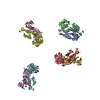
|
|---|---|
| 1 | x 60
|
| 2 |
|
| 3 | x 5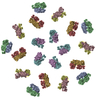
|
| 4 | x 6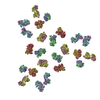
|
| 5 | 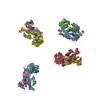
|
| Symmetry | Point symmetry: (Schoenflies symbol: I (icosahedral)) |
- Components
Components
| #1: Antibody | Mass: 23854.242 Da / Num. of mol.: 4 / Fragment: Fab / Source method: isolated from a natural source / Source: (natural)  #2: Antibody | Mass: 23196.947 Da / Num. of mol.: 4 / Fragment: Fab / Source method: isolated from a natural source / Source: (natural)  Has protein modification | Y | |
|---|
-Experimental details
-Experiment
| Experiment | Method: ELECTRON MICROSCOPY |
|---|---|
| EM experiment | Aggregation state: PARTICLE / 3D reconstruction method: single particle reconstruction |
- Sample preparation
Sample preparation
| Component |
| ||||||||||||||||
|---|---|---|---|---|---|---|---|---|---|---|---|---|---|---|---|---|---|
| Details of virus | Empty: NO / Enveloped: YES / Host category: INVERTEBRATES / Isolate: STRAIN / Type: VIRUS-LIKE PARTICLE | ||||||||||||||||
| Natural host | Organism: Aedes albopictus | ||||||||||||||||
| Buffer solution | Name: PBS / pH: 7.4 / Details: PBS | ||||||||||||||||
| Specimen | Conc.: 1 mg/ml / Embedding applied: NO / Shadowing applied: NO / Staining applied: NO / Vitrification applied: YES | ||||||||||||||||
| Specimen support | Details: 400 mesh C-flat grids | ||||||||||||||||
| Vitrification | Instrument: GATAN CRYOPLUNGE 3 / Cryogen name: ETHANE / Temp: 90 K / Humidity: 95 % Details: Blot for 2 seconds before plunging into liquid ethane (GATAN CRYOPLUNGE 3) Method: Blot for 2 seconds before plunging |
- Electron microscopy imaging
Electron microscopy imaging
| Microscopy | Model: FEI/PHILIPS CM300FEG/HE / Date: Jan 1, 2011 |
|---|---|
| Electron gun | Electron source:  FIELD EMISSION GUN / Accelerating voltage: 300 kV / Illumination mode: FLOOD BEAM FIELD EMISSION GUN / Accelerating voltage: 300 kV / Illumination mode: FLOOD BEAM |
| Electron lens | Mode: BRIGHT FIELD / Nominal magnification: 38000 X / Calibrated magnification: 39190 X / Cs: 2 mm Astigmatism: Objective lens astigmatism was corrected at 150000 times magnification Camera length: 0 mm |
| Specimen holder | Specimen holder model: GATAN LIQUID NITROGEN Specimen holder type: Side entry liquid nitrogen-cooled cryo specimen holder Tilt angle max: 0 ° / Tilt angle min: 0 ° |
| Image recording | Electron dose: 20 e/Å2 |
| Image scans | Num. digital images: 62 |
| Radiation | Protocol: SINGLE WAVELENGTH / Monochromatic (M) / Laue (L): M / Scattering type: x-ray |
| Radiation wavelength | Relative weight: 1 |
- Processing
Processing
| EM software |
| ||||||||||||
|---|---|---|---|---|---|---|---|---|---|---|---|---|---|
| CTF correction | Details: Each Micrograph | ||||||||||||
| Symmetry | Point symmetry: I (icosahedral) | ||||||||||||
| 3D reconstruction | Method: projection matching / Resolution: 15.6 Å / Resolution method: FSC 0.5 CUT-OFF / Num. of particles: 1728 / Actual pixel size: 2.22 Å Details: (Single particle details: The particles were selected using e2boxer) (Single particle--Applied symmetry: I) Symmetry type: POINT | ||||||||||||
| Atomic model building | Protocol: RIGID BODY FIT / Space: REAL / Target criteria: Sumf / Details: REFINEMENT PROTOCOL--rigid body | ||||||||||||
| Atomic model building | PDB-ID: 4GQ8 4gq8 Pdb chain-ID: B / Accession code: 4GQ8 / Source name: PDB / Type: experimental model | ||||||||||||
| Refinement step | Cycle: LAST
|
 Movie
Movie Controller
Controller






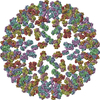
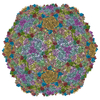
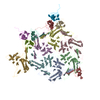

 PDBj
PDBj

